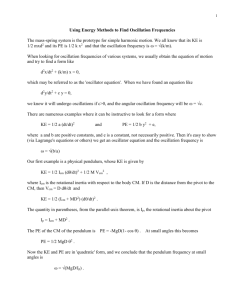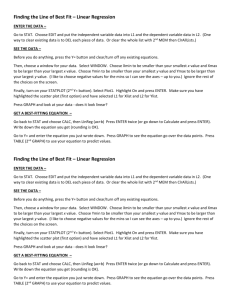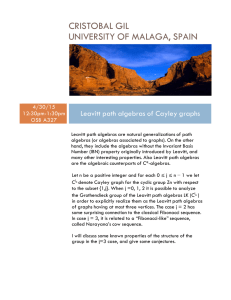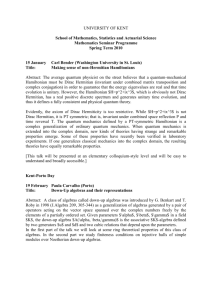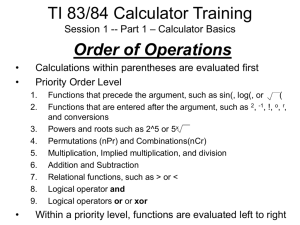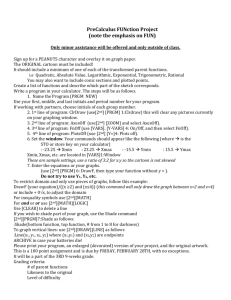A TOPOLOGICAL ISOMORPHISM INVARIANT FOR CERTAIN AF ALGEBRAS
advertisement
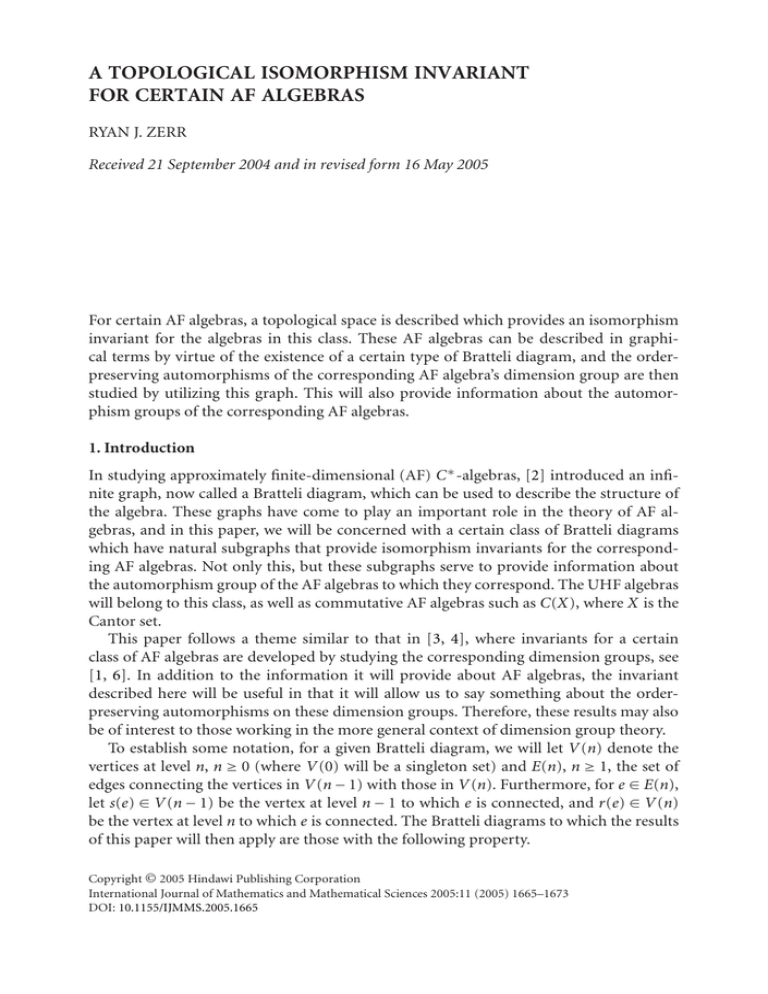
A TOPOLOGICAL ISOMORPHISM INVARIANT
FOR CERTAIN AF ALGEBRAS
RYAN J. ZERR
Received 21 September 2004 and in revised form 16 May 2005
For certain AF algebras, a topological space is described which provides an isomorphism
invariant for the algebras in this class. These AF algebras can be described in graphical terms by virtue of the existence of a certain type of Bratteli diagram, and the orderpreserving automorphisms of the corresponding AF algebra’s dimension group are then
studied by utilizing this graph. This will also provide information about the automorphism groups of the corresponding AF algebras.
1. Introduction
In studying approximately finite-dimensional (AF) C ∗ -algebras, [2] introduced an infinite graph, now called a Bratteli diagram, which can be used to describe the structure of
the algebra. These graphs have come to play an important role in the theory of AF algebras, and in this paper, we will be concerned with a certain class of Bratteli diagrams
which have natural subgraphs that provide isomorphism invariants for the corresponding AF algebras. Not only this, but these subgraphs serve to provide information about
the automorphism group of the AF algebras to which they correspond. The UHF algebras
will belong to this class, as well as commutative AF algebras such as C(X), where X is the
Cantor set.
This paper follows a theme similar to that in [3, 4], where invariants for a certain
class of AF algebras are developed by studying the corresponding dimension groups, see
[1, 6]. In addition to the information it will provide about AF algebras, the invariant
described here will be useful in that it will allow us to say something about the orderpreserving automorphisms on these dimension groups. Therefore, these results may also
be of interest to those working in the more general context of dimension group theory.
To establish some notation, for a given Bratteli diagram, we will let V (n) denote the
vertices at level n, n ≥ 0 (where V (0) will be a singleton set) and E(n), n ≥ 1, the set of
edges connecting the vertices in V (n − 1) with those in V (n). Furthermore, for e ∈ E(n),
let s(e) ∈ V (n − 1) be the vertex at level n − 1 to which e is connected, and r(e) ∈ V (n)
be the vertex at level n to which e is connected. The Bratteli diagrams to which the results
of this paper will then apply are those with the following property.
Copyright © 2005 Hindawi Publishing Corporation
International Journal of Mathematics and Mathematical Sciences 2005:11 (2005) 1665–1673
DOI: 10.1155/IJMMS.2005.1665
1666
A topological AF isomorphism invariant
Property 1.1. For each n ≥ 1 and each ei ,e j ∈ E(n), if r(ei ) = r(e j ), then s(ei ) = s(e j ).
In other words, each vertex at level n is connected to only one vertex at level n − 1.
This implies that the cardinality of the sets V (n) is such that |V (n + 1)| ≥ |V (n)|, and
therefore we may assume, without a loss of generality, that either |V (i)| = |V ( j)| for all
i, j = 0, or, by inserting levels of vertices if necessary, that |V (n)| = n + 1 for all n ≥ 0.
It should be noted that a given AF algebra, due to the fact that it has many different
Bratteli diagrams, may have one Bratteli diagram which satisfies Property 1.1 and others
which do not. One such example is the UHF 2∞ algebra, which can be represented by
each of the diagrams
•
•
•
...
•
...
•
(1.1)
•
•
....
The former diagram satisfies Property 1.1 and the latter does not.
Given a diagram satisfying Property 1.1, there will correspond a unique subgraph of
the Bratteli diagram (which is itself also a Bratteli diagram), which we will call Gmin , with
the same vertex sets V (n), n ≥ 0, as the Bratteli diagram, but with edge sets E (n) ⊂ E(n)
having the following additional property: for each v ∈ V (n), there exists a unique edge
e ∈ E (n) such that r(e) = v. For the diagram above and on the left, the subgraph Gmin
will simply be the graph with a single vertex at each level and a single edge connecting
these vertices. See Example 3.6 for another such example.
The primary object of interest in this paper will then be the topological space Xmin
obtained from the graph Gmin by letting Xmin be the set of all infinite paths in Gmin . To
describe the topology on Xmin , we let B(v) be the set of all infinite paths in Gmin which
pass through the vertex v ∈ V (n). The collection of all such subsets will form a basis for
the topology on Xmin . This makes Xmin into a compact 0-dimensional (basis consisting of
sets which are both open and closed) Hausdorff space. We note in passing that Xmin is the
spectrum of the commutative AF algebra with Bratteli diagram given by Gmin .
The set Xmin is also referred to in [8] in the context of ordered Bratteli diagrams. There,
Xmin is the set of all infinite paths in the ordered diagram for which each edge is minimal. Our definition amounts to the same as in [8] for those Bratteli diagrams satisfying Property 1.1. For more general (ordered) Bratteli diagrams, the set Xmin will depend
on the order placed on the edges. That is to say, for a given ordered Bratteli diagram,
different orderings of the edges will lead to different (nonhomeomorphic) possibilities
for Xmin . For the Bratteli diagrams considered here, this ambiguity does not arise as any
order placed on the edges will yield the same set Xmin . In a more general setting such as
[8], some of the results obtained here will still be possible. However, the nonuniqueness
of Xmin in this case means that the order structure of the corresponding dimension group
is significantly more complicated, see [9, Example 4.5].
To briefly preview what follows, we comment that the results of this paper will generalize the following three facts about the AF algebra C(X), where X is a 0-dimensional
compact Hausdorff space.
Ryan J. Zerr
1667
(i) The dimension group of C(X) can be identified with C(X, Z), the continuous functions from X to Z. Such dimension groups are not uncommon in the literature, such as
in [10, 11], where certain AF subalgebras of crossed product algebras are studied. For an
AF algebra A with a Bratteli diagram satisfying Property 1.1, it will be shown that the
dimension group of A can be identified with a subgroup of C(Xmin , Q). In this case, the
set Xmin will be in general a proper closed subspace of the spectrum of the MASA D ⊂ A
which is spanned by the diagonal matrix units in A.
(ii) If C(X1 ) ∼
= C(X2 ), then X1 and X2 are homeomorphic. We show that for AF algebras A1 ∼
= A2 which have diagrams satisfying Property 1.1, the sets Xmin,1 and Xmin,2 are
homeomorphic (Theorem 2.1).
(iii) The order-preserving automorphisms ψ on the dimension group of C(X) are of
the form ψ( f ) = f ◦ φ for φ : X → X a homeomorphism. We will show that this carries
over to AF algebras with Bratteli diagrams satisfying Property 1.1 with X replaced by
Xmin .
2. Dimension groups of continuous functions
lim
(A ,φ ) be a unital AF algebra with unital injective ∗-homomorTo begin, let A = −
→ n n
phisms φn and suppose that the Bratteli diagram for A satisfies Property 1.1. As mentioned earlier, we may assume, without a loss of generality, that either |V (n)| is constant
or |V (n)| = n + 1 for all n. We begin by considering the latter case. One can then show
that, up to unitary equivalence, the connecting homomorphisms φn correspond to multiplicity matrices (see, e.g., [5]) of the form
an1,1
An,n+1 =
..
,
.
anj(n), j(n)
anj(n)+1, j(n)
anj(n)+2, j(n)+1
..
.
(2.1)
ann+2,n+1
for some 1 ≤ j(n) ≤ n + 1, where all unspecified entries are zero. By choosing nonzero
integers bn (= a j(n)+1,n+2 ) define, for all n ≥ 0,
An,n+1 =
an1,1
..
bn
,
.
anj(n), j(n)
anj(n)+1, j(n)
anj(n)+2, j(n)+1
..
.
ann+2,n+1
1
exists.
in which case the inverse A−n,n+1
(2.2)
1668
A topological AF isomorphism invariant
Now define, for all n ≥ 1, the linear maps Rn : Qn+1 → C(Xmin , Q), where C(Xmin , Q)
are the continuous functions from Xmin to Q (giving Q the discrete topology), by
Rn α1 ,...,αn+1 = α1 χB(1,0) +
n
−1
αl+2 χB( j(l)+1,l+1) ,
(2.3)
l=0
where χA is the function which is equal to 1 on A and 0 on Ac , and as a notational convenience, we write B(i,n) to denote the clopen subset of Xmin which consists of all infinite
paths passing through the vertex vi (n) ∈ V (n). Here we are labeling the vertices at level
n by v1 (n),...,vn+1 (n), where the vertex vi (n) corresponds to the ith row/column in the
corresponding multiplicity matrices. It is left to the reader to show that Rn injects.
K (A ).
To compute the dimension group K0 (A), we utilize the fact that K0 (A) = lim
−→ 0 n
However, to be more explicit about the nature of −
lim
K
0 (An ), we define, for all n ≥ 1,
→
An = A−0,11 ⊕ In−1 · · · A−n−1 2,n−1 ⊕ I1 A−n−1 1,n .
(2.4)
Note that An has rational entries. Then, let Φn : Zn+1 → C(Xmin , Q) be given by Φn =
Rn ◦ An . To show that K0 (A) can be identified with a subgroup of C(Xmin , Q), we would
like to show that the diagram
∼ Zn+1
K0 An =
φn∗
∼ Zn+2
K0 An+1 =
(2.5)
Φn+1
Φn
C Xmin , Q
commutes, where φn∗ is the homomorphism induced by the standard embedding φn :
An → An+1 .
Let (α1 ,...,αn+1 )T ∈ Zn+1 . Then, Φn+1 ◦ φn∗ (α1 ,...,αn+1 )T equals
T
1
Rn+1 ◦ A−0,11 ⊕ In · · · A−n−1 1,n ⊕ I1 A−n,n+1
◦ An,n+1 α1 ,...,αn+1 ,0 .
(2.6)
n −1 T
) = A−n−1 1,n (α1 ,...,αn+1 )T and, in general, for 2 ≤ i < n, (β1n−i ,
If we define (β1n−1 ,...,βn+1
i
i+1 T
...,βnn−−i+2
)T = A−n−1 i,n−i+1 (β1n−i+1 ,...,βnn−−i+2
) , we see that Φn+1 ◦ φn∗ (α1 ,...,αn+1 )T equals
n −1
,0
Rn+1 ◦ A−0,11 ⊕ In · · · A−n−1 2,n−1 ⊕ I2 β1n−1 ,...,βn+1
n −1
= Rn+1 β10 ,β20 ,β31 ,...,βnn−2 ,βn+1
,0
= β10 χB(1,0)
+
n
−1
l =0
l
βl+2
χB( j(l)+1,l+1) .
T
(2.7)
Ryan J. Zerr
1669
n −1
), and thus Φn = Φn+1 ◦ φn∗ . We
However, Φn (α1 ,...,αn+1 )T = Rn (β10 ,β20 ,β31 ,...,βnn−2 ,βn+1
conclude that the diagram commutes. By the universal property of the direct limit, it
follows that there exists a homomorphism Ψ : K0 (A) → C(Xmin , Q). Since each of the
maps Φn is injective, Ψ injects.
Next, we consider the nature of the positive cone K0+ (A). Letting (α1 ,α2 )T ∈ Z2 , we see
that Φ1 (α1 ,α2 )T equals
R1
α1 α2 α1 a02,1
, −
a01,1 b0 a01,1 b0
=
α1
α2 α1 a02,1
−
χ
0 χB(1,0) +
b0 a01,1 b0 B(2,1)
a1,1
(2.8)
α1
α1 α2 α1 a02,1
= 0 χB(1,1) +
+ −
χ ,
a1,1
a01,1 b0 a01,1 b0 B(2,1)
since B(1,0) = B(1,1) ∪ B(2,1). This is simply (α1 /a01,1 )χB(1,1) + (α2 /a02,1 )χB(2,1) if we choose
b0 = a02,1 . In order to obtain a convenient description of K0+ (A), we would like to show
that there exists a sequence {bn }∞
n=0 of positive integers such that for every n ≥ 1,
Φn α1 ,...,αn+1
T
=
n+1
αi
χ ,
k(i,n) B(i,n)
i =1
(2.9)
where k(i,n) ∈ Z+ , for all 1 ≤ i ≤ n + 1. Our above calculations prove that it is possible to
choose b0 accordingly.
Assume that b0 ,...,bk−1 ∈ Z+ have been chosen in order to guarantee that Φk is of the
appropriate form for 1 ≤ k ≤ n. Let (α1 ,...,αn+2 )T ∈ Zn+2 . Then,
Φn+1 α1 ,...,αn+2
T
= Rn+1
T
0 −1 A
α ,...,αn+2 ,
1 n,n+1 1
An
0
(2.10)
from which it follows that Φn+1 (α1 ,...,αn+2 )T is equal to
Φn
n
α j(n)+1 α j(n) a j(n)+1, j(n)
α j(n)
α j(n)+2
αn+2
α1
,..., n
,
,..., n
+
−
χB( j(n)+1,n+1) .
an1,1
a j(n), j(n) anj(n)+2, j(n)+1
an+2,n+1
bn
bn anj(n), j(n)
(2.11)
Hence, by the induction hypothesis, Φn+1 (α1 ,...,αn+2 )T equals
j(n)
i=1
n
n+1
α j(n)+1 α j(n) a j(n)+1, j(n)
αi
αi+1
−
χB( j(n)+1,n+1) .
χB(i,n) +
χB(i,n) +
n
n
ai,i k(i,n)
a
k(i,n)
bn
bn anj(n), j(n)
i= j(n)+1 i+1,i
(2.12)
Now, we note that for 1 ≤ i ≤ j(n) − 1, B(i,n) = B(i,n + 1), and for j(n) + 1 ≤ i ≤ n +
1, B(i,n) = B(i + 1,n + 1). Furthermore, B( j(n),n) = B( j(n),n + 1) ∪ B( j(n) + 1,n + 1).
1670
A topological AF isomorphism invariant
Thus, Φn+1 (α1 ,...,αn+2 )T becomes
j(n)
i=1
αi
αi+1
χB(i,n+1) +
χ
n
n
ai,i k(i,n)
a
k(i,n) B(i+1,n+1)
i+1,i
i= j(n)+1
n+1
anj(n)+1, j(n) k j(n),n
α j(n)
1−
+ n
bn
a j(n), j(n) k j(n),n
χB( j(n)+1,n+1) +
α j(n)+1
χ
.
bn B( j(n)+1,n+1)
(2.13)
If we let bn = anj(n)+1, j(n) k( j(n),n), then we have the desired outcome.
The significance of this is that when determiningthe positive cone K0+ (A), we see that
+
since the image of K0+ (A) inside of C(Xmin , Q) is n≥1 Φn (Zn+1
+ ), clearly K0 (A) can be
+
identified with a subset of C(Xmin , Q ). Furthermore, for all U ⊂ Xmin clopen, each function χU will be an element of the positive cone. Therefore, for such AF algebras, the hypotheses of the following theorem are satisfied.
Theorem 2.1. Suppose that A1 and A2 are AF algebras such that there exist injective homomorphisms Ψi : K0+ (Ai ) → C(Xi , Q+ ), for i = 1,2, where the sets Xi are 0-dimensional
compact Hausdorff spaces and where each Ψi maps the order unit of K0 (Ai ) to χXi . Assume
further that for all U ⊂ Xi clopen, χU ∈ Ψi (K0+ (Ai )). If ψ : K0 (A1 ) → K0 (A2 ) is an orderpreserving isomorphism taking order unit to order unit, then X1 and X2 are homeomorphic.
Proof. To begin, letx ∈ X1 and take {Un }∞
n=1 to be a decreasing sequence of clopen subsets
U
.
Then,
suppressing
explicit mention of the maps Ψi , we have
in X1 with {x} = ∞
n
n =1
χX2 = ψ(χX1 ) = ψ(χUn ) + ψ(χUnc ), for all n ≥ 1, where Unc is the complement of Un in X1 . If
we suppose that the supports of the functions ψ(χUn ) and ψ(χUnc ) are not disjoint, then
there exists a nonempty clopen set V ⊂ X2 such that αχV ≤ ψ(χUn ), ψ(χUnc ), where α ∈
Q+ , α = 0. Because ψ −1 is order preserving, it follows that ψ −1 (αχV ) ≤ χUn , χUnc , implying
that ψ −1 (αχV ) = 0 since Un ∩ Unc = ∅. Thus, αχV = 0, a contradiction, and we conclude
that ψ(χUn ) and ψ(χUnc ) have disjoint supports. Therefore, by continuity, there exists a
nonempty clopen subset Vn ⊂ X2 such that ψ(χUn ) = χVn , for all n ≥ 1. Because {χUn }∞
n =1
∞
is a decreasing sequence in C(X1 , Q), {χVn }∞
n }n=1 is a
n=1 decreases in C(X2 , Q), and {V
decreasing sequence of clopen sets. It is relatively straightforward to show that ∞
n=1 Vn is
a singleton, and so we let y be the lone element in this intersection.
Define θ : X1 → X2 by letting θ(x) = y, for all x ∈ X1 . Clearly, this map is well defined
since any two sequences {Un }, {Un } which decrease down to {x} can be intertwined,
resulting in the intertwining of the corresponding sequences {Vn } and {Vn }. It is also
clear that θ is a bijection. Finally, for U clopen in X1 , one sees that if ψ(χU ) = χV , then
θ(U) = V . Therefore, θ is an open map, and similarly so is its inverse. Hence, X1 is home
omorphic to X2 .
3. Applications and further questions
Considering those AF algebras which have a Bratteli diagram satisfying Property 1.1, we
have the following corollaries of Theorem 2.1.
Ryan J. Zerr
1671
Corollary 3.1. Let A1 and A2 be AF algebras, each with Bratteli diagrams satisfying
1
2
is homeomorphic to Xmin
.
Property 1.1. If A1 ∼
= A2 , then Xmin
Corollary 3.2. Suppose that A is an AF algebra with a Bratteli diagram satisfying Property
1.1. Then, under the identification of K0 (A) with a subgroup of C(Xmin , Q) as above, every
order-preserving automorphism ψ of K0 (A) which takes the order unit onto itself must be of
the form ψ( f ) = f ◦ θ −1 for some homeomorphism θ of Xmin .
Remark 3.3. When a Bratteli diagram satisfies Property 1.1 and |V (n)| remains constant
for all n ≥ 1, the multiplicity matrices for the corresponding AF algebra are permutation
similar to diagonal matrices. Thus, the above results generalize to this situation as well.
Remark 3.4. One can use Corollary 3.2 to provide a new proof of the well-known result
that identifies automorphisms on C(X), X a 0-dimensional compact metric space, with
homeomorphisms on X, see [7, Theorem 3.4.3].
We now mention some applications of Corollary 3.2 which provide information about
the automorphism groups of certain AF algebras.
Corollary 3.5. Suppose that A is an AF algebra with a Bratteli diagram satisfying Property
1.1. If the only homeomorphism of Xmin is the identity map, then Aut(A) = Inn(A).
Proof. Each automorphism α ∈ Aut(A) induces an automorphism α∗ ∈ Aut(K0 (A)). By
Corollary 3.2, α∗ (g) = g ◦ θ −1 for some homeomorphism θ of Xmin , where we are identifying K0 (A) with a subgroup of C(Xmin , Q). By hypothesis, it follows that α∗ = id∗ , and
therefore, by [5, Theorem IV.5.7], α ∈ Inn(A). Hence, Aut(A) = Inn(A). In particular,
this applies to the UHF algebras, and should be compared with [5, Corollary IV.5.8]. The converse of Corollary 3.5 is in general not true. The following example illustrates
this and demonstrates an application of Corollary 3.2 which utilizes the structure of Xmin
to obtain complete information about the automorphism groups of K0 (A) and A.
Example 3.6. Consider the AF algebra A with Bratteli diagram
•
•
•
•
•
..
..
.
•
(3.1)
.
where the multiplicity matrices are such that
1
An,n+1 =
..
.
1
∈ Mn+2,n+1 ,
n+1
2
1
(3.2)
1672
A topological AF isomorphism invariant
for all n ≥ 0. In defining the matrix An,n+1 , if we choose the sequence {bn } from Section 2
so that bn = 1 for all n, one can verify by induction on n that
2 −1
−2−1
.
2 −2
−2−2
An =
..
.
2 −n
−2−n
(3.3)
1
With Xmin given (uniquely) as the set of all infinite paths in the graph
•
•
•
•
•
(3.4)
•
..
.
we have, for any (α1 ,...,αn+1 )T ∈ Zn+1 , that
Φn α1 ,...,αn+1
T
=
n
αl 2−l χB(l,n) + αn+1 χB(n+1,n) .
(3.5)
l =1
By Corollary 3.2, every order-preserving automorphism ψ of K0 (A) must be of the
form ψ( f ) = f ◦ θ −1 for some homeomorphism θ of Xmin , where f ∈ K0 (A) ⊂ C(Xmin ,
Q). The set Xmin is easily seen to be homeomorphic to {1/n : n ∈ Z+ }, and thus, any
homeomorphism θ of Xmin must fix the point corresponding to 0. It follows that if θ
is a nonidentity homeomorphism of Xmin , then there exist n ≥ 1 and 1 ≤ l1 < l2 ≤ n such
that θ(B(l1 ,n)) = B(l2 ,n), where here, B(l1 ,n) and B(l2 ,n) are singletons. But then, for the
function f = 2−l1 χB(l1 ,n) + 2−l2 χB(l2 ,n) ∈ K0 (A), we see that
ψ( f ) = f ◦ θ −1 = 2−l1 χB(l2 ,n) + 2−l2 χB(l1 ,n) ∈
/ K0 (A).
(3.6)
Hence, we conclude that the only order-preserving automorphism of K0 (A) is the identity
map.
Consequently, the converse of Corollary 3.5 is not true. After all, we have just shown
that the only order-preserving automorphism of K0 (A) is the identity map. So again, by
[5, Theorem IV.5.7], Aut(A) = Inn(A). However, Xmin clearly has many nontrivial homeomorphisms.
As some of the results here generalize certain well-known results from the theory of
AF algebras, a natural next question is how much the results in the present paper can be
generalized further. It is possible to define a generalization of the set Xmin , such as in [8]
for ordered Bratteli diagrams, for an arbitrary AF algebra. The nonuniqueness of Xmin in
this case is problematic, but it may still be possible to generalize some of the results here
to fit into this context.
Ryan J. Zerr
1673
Furthermore, it would be interesting to know if being able to embed an AF algebra’s
dimension group into a dimension group of the form (C(X, Q),C(X, Q+ ),χX ), where X
is a 0-dimensional compact Hausdorff space, is sufficient for its having a Bratteli diagram
satisfying Property 1.1.
Acknowledgments
The author would like to thank Dr. Justin Peters for his many helpful suggestions and an
anonymous reviewer for suggestions which helped to clarify the exposition.
References
[1]
[2]
[3]
[4]
[5]
[6]
[7]
[8]
[9]
[10]
[11]
B. Blackadar, K-Theory for Operator Algebras, 2nd ed., Mathematical Sciences Research Institute Publications, vol. 5, Cambridge University Press, Cambridge, 1998.
O. Bratteli, Inductive limits of finite dimensional C ∗ -algebras, Trans. Amer. Math. Soc. 171
(1972), 195–234.
O. Bratteli, P. E. T. Jorgensen, K. H. Kim, and F. Roush, Computation of isomorphism invariants
for stationary dimension groups, Ergodic Theory Dynam. Systems 22 (2002), no. 1, 99–127.
O. Bratteli, P. E. T. Jorgensen, and V. Ostrovs’kyı̆, Representation theory and numerical AFinvariants. The representations and centralizers of certain states on ᏻd , Mem. Amer. Math.
Soc. 168 (2004), no. 797, xviii+178.
K. R. Davidson, C ∗ -Algebras by Example, Fields Institute Monographs, vol. 6, American Mathematical Society, Rhode Island, 1996.
G. A. Elliott, On the classification of inductive limits of sequences of semisimple finite-dimensional
algebras, J. Algebra 38 (1976), no. 1, 29–44.
R. V. Kadison and J. R. Ringrose, Fundamentals of the Theory of Operator Algebras. Vol. I, Pure
and Applied Mathematics, vol. 100, Academic Press, New York, 1983.
J. R. Peters and Y. T. Poon, Z-analytic TAF algebras and partial dynamical systems, J. Operator
Theory 50 (2003), no. 2, 387–409.
J. R. Peters and R. J. Zerr, Partial dynamical systems and AF C ∗ -algebras, Houston J. Math. 31
(2005), no. 2, 463–494.
Y. T. Poon, AF subalgebras of certain crossed products, Rocky Mountain J. Math. 20 (1990), no. 2,
527–537.
I. F. Putnam, The C ∗ -algebras associated with minimal homeomorphisms of the Cantor set, Pacific
J. Math. 136 (1989), no. 2, 329–353.
Ryan J. Zerr: Department of Mathematics, College of Arts and Sciences, University of North
Dakota, Grand Forks, ND 58202-8376, USA
E-mail address: ryan.zerr@und.nodak.edu

